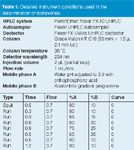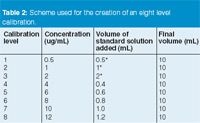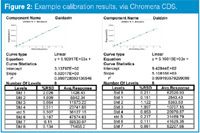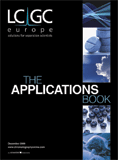Increased Throughput and Reduced Solvent Consumption for the Determination of Isoflavones by UHPLC
The Application Notebook
All plant foods are complex mixtures of chemicals including both nutrients and biologically active non-nutrients, referred to as phytochemicals. Soy is known for having high concentrations of several physiologically-active phytochemicals, including isoflavones, phytate (inositol hexaphosphate), saponins, phytosterols and protease inhibitors. The isoflavones are what makes soy unique.
Introduction
All plant foods are complex mixtures of chemicals including both nutrients and biologically active non-nutrients, referred to as phytochemicals. Soy is known for having high concentrations of several physiologically-active phytochemicals, including isoflavones, phytate (inositol hexaphosphate), saponins, phytosterols and protease inhibitors. The isoflavones are what makes soy unique. Recent data has demonstrated that isoflavones have potent antioxidant properties, comparable to that of the well known antioxidant vitamin E2 . Research in several areas of healthcare has linked isoflavones in lowering risk for disease, easing menopause symptoms, reducing heart disease and cancer risk, and improving against prostate and bone health. As a result of the potential health benefits of isoflavones many soy products and isoflavone supplements are available to consumers. These fall into a category of products known as nutraceuticals or functional foods, which provide a potential health benefit from a naturally occurring substance. This has created the need for an analytical technique that can qualify and quantify the type and amount of isoflavones in a nutraceutical product.
This application note will demonstrate a rapid method for the identification and quantification soy isoflavones using ultra high performance liquid chromatography (UHPLC). This UHPLC method is nearly 10× faster and saves 92% of the mobile phase solvent, compared to conventional HPLC methods.

Table 1
The focus will be on three major isoflavones found in soybeans, genistein, daidzein and glycitein, and their glycosidic conjugates. In addition to qualitative and quantitative analysis we will compare the analytical time and solvent use of this UHPLC application with a similar technique using conventional HPLC. The savings in both time and solvent consumption will be discussed. Lastly, three commercial formulations of supplements will be analysed and isoflavone identification and content determined.
Experimental
The PerkinElmer Flexar FX-10 UHPLC system was used for this application. A 1.5 µm particle, 50 mm length, C18 column was used to separate the analytes of interest and matrix. This column required an operating pressure of approximately 8500 psi resulting in a mobile phase flow-rate of approximately 0.7 mL/min. A Flexar FX-UV/vis UHPLC detector was operated at 254 nm. Table 1 presents the detailed operating parameters of the UHPLC system. The instrument interaction, data analysis and reporting was completed with the PerkinElmer, Chromera data system.

Table 2
Standard preparation: The reference standards were procured from Chromadex (Irvine, California, USA).
Stock solution: One mg of each of daidzin, glycitin, genistin, daidzein, glycitein and genistein were dissolved in 10 mL of water:acetonitrile (1:1), making a stock solution at a concentration of 100 µg/mL.
Calibration curve: The stock solution (100 µg/mL) was diluted in 9:1 (water:acetonitrile) to create an 8 level calibration (Table 2). The three low calibration points were serially diluted from the 10 µg/mL level, to reduce inaccuracies in the measurement to small volumes. The diluent in the calibration curve was used so that the solvent composition was as close as possible to the mobile phase composition at the time of injection. This will minimize baseline disturbance associated with injection. This is especially important in UHPLC where peak shapes can be distorted as a result of disturbance of the mobile phase composition.

Table 3
Calibration: The UV detector was calibrated across the range of 0.5 to 12 µg/mL, each calibration point was run in triplicate to demonstrate the precision of the system. The average coefficient of determination for a line of linear regression was 0.9965 for all six compounds. The calibration curves for daidzein and daidzin are pictured in Figure 2. Also in Figure 2 is the percent relative standard deviation (%RSD) for each calibration point (n = 3). The precision of the system across the calibration range is excellent, the %RSD for diadzein and diadzin with an average of approximately 0.5%.

Figure 1
Sample preparation: Three commercially available supplements were analysed with the method developed here. The samples are referred to as: sample 1, sample 2 and sample 3. The sample preparation used was relatively straightforward. A 0.5 gram sample of each supplement was ground with a mortar and pestle. The ground sample was extracted in 100 mL of (1:1) water: acetonitrile, in an ultrasonic bath. The sample extracts were filtered through a 0.2 µm nylon filter. Following filtration, 2 mL of sample extract was diluted to 10 mL final volume in 9:1 water:acetonitrile, this reduced the concentration of the isoflavones in the extract within the range of the calibration curve and made the diluents and mobile phase more alike.
Results
Under the conditions presented here, the analytical run was 4.5 minutes long with an elution order of daidzin, glycitin, genistin, daidzein, glycitein and genistein. In similar applications performed with conventional HPLC, the analytical run time was 43 minutes. Therefore, this method has reduced the run time by 38.5 minutes, while maintaining complete resolution of all analyte peaks. The minimum resolution (critical pair) of analytes in this separation was 2.8, occurring between daidzin and glycitin.

Figure 2
The analysis of samples 1 and 2 resulted in detection of significant levels of isoflavones, with 49 and 52 mg of isoflavones in each sample, respectively. The label on the bottle for both samples 1 and 2 stated that each contained 55 mg of isoflavones per tablet, the determined values for each sample equate to 89% and 95% recovery. The sample analysis is summarized in Table 3. The analysis of sample 3 resulted in no detection of isoflavones; this was expected, as sample 3 was a multi-vitamin that did not list any isoflavones on its label.

Figure 3
Conclusions
The technique presented in this application note applies UHPLC instrumentation to the determination of isoflavones in nutraceutical supplements. A commercial reference standard was used to identify 3 isoflavones and their glycosidic conjugates by retention time. The separation used a short small particle (1.5 µm) LC column and achieved adequate resolution of all isoflavone peaks commonly found in soy materials. A multilevel calibration curve using the UV/vis detector at 254 nm was used to quantitatively determine the amount of isoflavone in three dietary supplements. In addition to providing a precise and accurate result for the determination of isoflavones in supplements, this UHPLC application has reduced the analytical runtime by nearly 10× and eliminated nearly 40 mL of solvent use per sample. When compared to conventional HPLC, this directly translates into solvent savings of 92%.

References
1. www.soyconnection.com, IsofavonesFactSheet.pdf
2. http://www.isoflavones.info,
PerkinElmer Inc.
940 Winter Street, Waltham, Massachusetts 02451, USA
tel. +1 800 762 4000 Website: www.perkinelmer.com

Pick Your Poison. Isolation of Paclitaxel (Mar 2025)
March 7th 2025The diterpenoid, paclitaxel, which was identified as a potent chemotherapy agent for breast and ovarian cancer originates from the Pacific Yew tree. The isolation of paclitaxel from its major impurities is shown with the use of Hamilton’s PRP-1 (5 µm) HPLC column.














